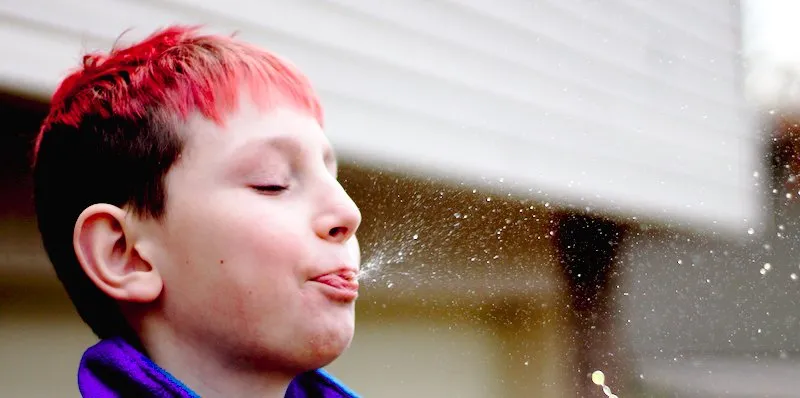We’ve all been there. You pour that tall, refreshing glass of orange juice to go with your breakfast. But, the bitter blast that fills your mouth tastes nothing like orange juice! Has it gone rancid? You quickly spew that loathsome liquid into the sink and check the date on the box. It shouldn’t go bad for another week. What is going on? Then, it dawns on you: you just brushed your teeth!

Image taken by me
Why does everything taste weird after you brush your teeth?
This was the question that my son asked on the way to school the other morning, but I didn't have an answer for him. It kind of bothered me! I told him that I would look into it and get back with him. But, as always, nothing can be simple. So, to get to the answer, we're gonna have to wade through some of the background science. Or, if you don’t feel like putting your boots on, you can just skip to the bottom of the article for the watered down answer.
Our Sense Of Taste
When we talk about ‘our sense of taste’, we are generally referring to the flavor profile we get from our food. That profile is made up of 5 basic flavors: sweet, sour, salty, bitter, and umami. You’re probably very familiar with those first four, but you may not have heard of umami. It is a Japanese word that means savory. It is named for Japanese scientist Kikunae Ikeda, who discovered receptors specifically adapted to pick up glutamic acid and aspartic acid, two compounds that our brain interprets as that savory flavor we get from things like meat broths. As for the other flavors, sweet comes from simple carbohydrates, acids are experienced as sour, and we perceive a whole host of compounds as bitter. In fact, our ability to taste bitter substances is probably our most developed, perhaps as a defense mechanism to help us identify toxins in plant based foods
Why Do We Taste
For modern humans, we taste of our food to see if we will like it. We eat things that we enjoy and avoid those that we don’t. But, for our ancestors, the ability to taste their food was all about survival. The taste of food can give important clues about its nutritional value, as well as whether or not the item has gone rancid or is toxic. Sweet and salty flavors are generally associated with high nutrient values, whereas bitter flavors indicate toxicity. Furthermore, it seems that the brain has a way of knowing which nutrients the body is lacking, and it urges you to consume foods that contain them by enhancing that feeling of satisfaction you feel from eating them. One of the educational videos that I show in my classroom every year tells the story of a man who was stranded on a life raft in the ocean. He was somehow able to catch some fish to eat. At first, he exclusively devoured the musculature of the fish. (For those not familiar: whenever you dine on fish - or any meat for that matter- it is usually the muscle that you are eating.) As time went on, he found himself eating other parts of the fish, like its eyeballs. Even though he would have found this repulsing under normal circumstances, his brain knew that the fluid in the eyes contained nutrients that he just couldn’t get from the fish’s flesh. It was able to make this determination from the compounds detected by his sense of taste.
How Do We Taste?
Many people assume that their sense of taste comes from the taste buds on their tongue. And, those people would be partly correct. Taste buds do play a large part in how we perceive the flavor of our food. However, our sense of smell also plays a large role. Both of these senses work by a similar mechanism called chemosensation. Chemosensation, or chemoreception is the ability to perceive chemicals from the environment. This usually happens when compounds bind to nerve receptors that are specifically designed to receive that chemical. Humans are especially adapted to blending their sense of taste with their sense of smell to develop the rich flavor profiles of their food. That is why our sense of taste feels muted when we have a cold or a stuffy nose. I could probably finish out an entire article about this dynamic, but right now I want to focus on the toothpaste question. To get to the bottom of it, we need to focus on the taste buds.
The Tongue Map
Remember the tongue map that we all learned about in school? You know; the one where your sweet taste buds are on the tip of your tongue, salt taste buds are on the front sides, sour on the back sides, and bitter are in the back. Yeah. FORGET about all of that nonsense. This should have been an easy misconception to break, but no one bothered to challenge it until the 1970s. Even then, it somehow persisted in our high schools and popular culture for decades! In reality, we have taste buds for all five tastes spread throughout our entire tongue. Don’t believe me? Touch the tip of your tongue to a lemon. I’ll bet it will taste sour!Taste Buds
I’ll bet you think that all of those little bumps on your tongue are your taste buds. That’s what I thought when I started researching for this article. But, those are actually papillae, the structures that contain your taste buds. They occur on your soft palate, epiglottis, and upper esophagus, in addition to your tongue. There are four types of papillae: fungiform, filiform, circumvallate, and foliate.Fungiform papillae get their name from their mushroom-like shape. They mostly occur on the first ⅔ of the tongue, and they are sensitive to compounds that have sweet or sour flavors. Each one of these papillae can have up to 15 taste buds embedded in them.
Filiform papillae are the most numerous of the four. Most of them are roughly cone-shaped, and they are found surrounding the fungiform papillae on the tongue. Their function is purely mechanical, as they contain no taste buds. They actually help the tongue grip food and move it around while chewing.
Circumvallate papillae, also called vallate papillae, are the largest and least numerous of the four papillae types. They occur as large, dome-shaped bumps on the back of the tongue that form a v-shape. Each of the 10 - 12 circumvallate papillae contain roughly 250 taste buds that sense taste and help to measure the amount of fat in our food. They also have their own special salivary glands called von Ebner’s glands that help to flush food out of the crevices between the papillae.
Foliate papillae look like little folds that are located on the sides of the tongue just in front of the vallate papillae. They [contain about 1000 taste buds](http://www.juniordentist.com/list-of-papillae-of-tongue-location-and-histology.html0 and are involved in sensing taste.
The taste buds that are embedded within the papillae are the actual sense organs of the tongue. Each one contains anywhere from 10 - 50 sensory cells that fit together to form a capsule with a flower bud shape. The tip of the capsule works to funnel fluid (presumably containing compounds from chewed food) down to the sensory cells where chemicals bind to the sensory cells. Each sensory cell within a taste bud is set up to receive one type of chemical cue. When the right chemical binds to the receptor cell, it causes that cell to start a nerve impulse that travels to the brain. The brain can evaluate how many sensory cells for each taste are sending signals along with the strength of each signal and blend that information together to generate the flavor profile for a particular bite of food. And you thought you were bad at math!
Now, The Moment We’ve All Been Waiting For
What does all of this have to do with toothpaste making stuff taste funny? Well, truth be told, I probably could have skipped all of it and just cut to the chase, but I thought it was pretty interesting.
Sodium Lauryl Sulfate
 Image Credit
Image Credit
Most toothpastes contain a chemical called sodium lauryl sulfate. It’s the stuff that causes your toothpaste to foam up as you brush. It acts as a detergent, emulsifying fatty substances and dissolving proteins so they can be more easily removed from the teeth. But it has a side effect (possibly a list of side effects, but we’ll leave that for another article). Sodium lauryl sulfate temporarily binds to the sweet taste receptors on your tongue, but it doesn’t cause those receptors to send a message to the brain. So your ability to taste sweet is effectively blocked for as long as that sodium lauryl sulfate is present. But, that’s not all. In addition to blocking those sweet receptors, sodium lauryl sulfate dissolves a layer of phospholipids that usually cover your bitter taste receptors. Without that lipid covering, you get the full effect of those alkaline chemicals that your tongue experiences as bitter. It is this combination of muting your ability taste the sugars in the orange juice and ramping up your ability to detect the bitter alkaline chemicals that completely transforms the flavor profile of that orange juice into something totally disgusting!
So, there you have it! The reason why brushing your teeth makes stuff taste weird. I hope you have enjoyed reading this poste, and maybe you even learned something from it? If so, let me know in the comments. I always make it a point to upvote relevant comments!
